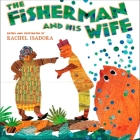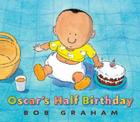What a depressing, jerky move from the folks at Penguin! I do think about race as one factor when I buy children's books, in pretty much the way you describe: I think it's a good idea for Eleanor and Isabel to have a variety of images of people in the books that surround them. (This is one of the reasons I've also been on the hunt for good books with same-sex couples in them. More on my favorites in that category in an upcoming post.)
Eleanor has, to date, never commented on the question of race, in terms of the people we know (and she has a somewhat mixed group of friends), illustrations in books, or depictions in movies. We recently watched the live-action Disney Cinderella starring Brandy, and I wondered if she would comment on the race-blind casting: Cinderella is black, the evil stepmother (Bernadette Peters) is white; one of the stepsisters is black, the other white; the king is white, the queen (Whoopi Goldberg) is black, and the prince is Filipino. Not a word, even when we discussed some of the differences between this version and the cartoon.
I'm always happy to open a book Eleanor has picked out at the library and find that the characters in it aren't all white. On Eleanor's friend Ian's recommendation, we checked out one such book yesterday, by Jane Ray:

The Apple-Pip Princess
It's a sweet fairy tale: a widowed king says he's going to retire and choose one of his three daughters to rule his kingdom. Each princess has to do something to prove her worth. Predictably, the two elder princesses are too selfish, and mess it up, while the third uses magical gifts of the land left to her by her mother to plant a lot of magic trees and win in spite of not being grand. It's a little bit treacly in places (the good princess is named Serenity), but the illustrations are wonderful, and Eleanor adores it. Everyone in the book is dark-skinned, and there's no mention of race.
On the fairy tale front, another library discovery of ours are the gorgeous retellings of classic tales illustrated in African-inspired collage by Rachel Isadora. The first of these we read was The Fisherman and His Wife.

The Fisherman and His Wife
Isadora's collages are vibrantly colored and energetic -- if we had a working scanner at the moment, I'd show you the ocean getting darker and more furious as the fisherman's wife continues to ask for ridiculous things from the flounder. We also like Isadora's versions of Hansel and Gretel and The Princess and the Pea, though be forewarned: Hansel and Gretel is a dark story, and the illustrations of the witch are quite frightening; and The Princess and the Pea is, at bottom, not an interesting story at all, though Isadora's illustrations of different African princesses are beautiful, and she teaches you how to say hello in three different African languages.
Then there are some of the gifts we've gotten from you. Three that pop immediately to mind:

Where Is Gah-Ning?
As we've said before, Bob Munsch is hysterical. This was the first of his books we'd ever read, and it has some of his trademark style: lots of pleasing repetition in the dialogue, as Gah-Ning tells her father she wants to go to Kapuskasing, and he says no to every way she could get there, followed by a totally ridiculous plot twist and a happy ending. Gah-Ning and her family are Chinese, and some of the other characters are white, but again, there's no mention of race.

Oscar's Half Birthday
Bob Graham includes a nice variety of characters in his books: in Oscar's Half Birthday, mom is black, dad is white, and the kids are mixed-race (as well as being supernaturally well-behaved, especially at bedtime). It's a very sweet depiction of an older sister and baby brother. We also liked Jethro Byrd, Fairy Child, in which Annabelle (the girl who sees the fairies) and her family are white, and all the fairies are darker-skinned -- possibly Latino?
Finally, there is the joyful, perfect poem of a book by Trisha Cooke, illustrated by Helen Oxenbury:

So Much
It's a story about waiting and having people arrive: a new family member comes in on every other page, with a catch-phrase ("Hello hello!" "Yooo-hooo!") and something they want to do to the baby ("I want to kiss the baby! I want to kiss him so much!"). On the alternating pages, all the people in the house sit and wait together, and the drawings become sepia-toned. The family is black, British, and incredibly warm. Helen Oxenbury's drawings of babies are pitch-perfect.
All of which is a long way of saying that, given books with the two covers you referenced in your last post, I'd be more likely to buy the one with the black kids. However, there are a number of other books I like better for addressing new sibling issues. What are your favorites in that category?
Love, Annie

Hi there,
ReplyDeleteNice blog. It came up on our google alerts for our own books. We have a new multicultural picture book that came out a few weeks ago called Dear Baby, It's a Colorful World. It's for little ones pre-K and younger. It sends an adorable cast of toddlers on adventures to learn about the moods of colors. It also introduces young children to the concept of diversity with a "colors of me" page. A playful frog hides in each color spread and makes for a fun "find the frog" interactive quality. We are a new press but fortunate to be working with very good people. This book was edited by former Scholastic Editor Kara LaReau. Let me know if would like a review book. Peek inside features are available on our website. Thanks!
Carol Casey
I have mentioned Jan Ormerod before, but must do so again. Eat Up, Gemma by Sarah Hughes is illustrated by her and features a black British family as well.
ReplyDeleteThis is a great post! I just sent the link along to several moms I know.
ReplyDeleteI am friends with a white couple with an adopted, African-American daughter, and they're always on the lookout for kids books that feature multi-racial families. Any additional suggestions?
Check out our list of "Books with racially diverse/mostly non-white characters" on the Picture Books list page: http://annieandaunt.blogspot.com/p/books-for-toddlers-picture-books.html
Delete